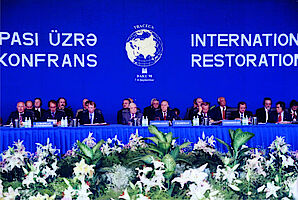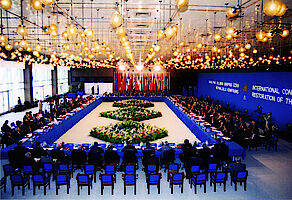Baku Initiative
… AND BASIC MULTILATERAL AGREEMENT AS A BASE FOR TRACECA PROGRAMME IMPLEMENTATION - STRATEGIC DIRECTION FOR BROADEN COOPERATION IN THE FIELD OF TRANSPORT ALONG EUROPE-CAUCASUS-ASIA CORRIDOR
Initially TRACECA (Transport Corridor Europe- the Caucasus-Asia) is aimed at developing a West-East transport corridor from Europe, across the Black Sea, through the South Caucasus and the Caspian Sea, built on the Trans-European Networks on the EU territory, the Pan European Transport Corridors in Europe, especially the Black Sea Pan European Transport Area and the New Silk Route to Asia.
After the start-up phase covering 1993-1995, projects focused on making the physical corridor operational and on strengthening the Black Sea–Caspian link as well as the Central Asian.
In September 1997 there was a welcome initiative by Presidents Aliyev of Azerbaijan and Shevardnadze of Georgia who jointly proposed to host a Presidential Conference in the Caucasus in 1998 that could lead to the signing of Basic Multilateral Agreement on Transport initiated within the TRACECA programme.
With the support of the TACIS-TRACECA programme of the European Union acting at that time, this initiative has resulted in the International Conference “TRACECA – Restoration of the Historic Silk Route” that held on 8 September 1998 in Baku (Republic of Azerbaijan).
The conference was attended by the Presidents of Azerbaijan, Bulgaria, Georgia, Kyrgyzstan, Moldova, Romania, Turkey, Ukraine and Uzbekistan, representatives of the European Commission, heads of governments and transport ministries and experts from 32 countries as well as representatives of 12 international organizations. The important achievement of the conference was the signing of the Basic Multilateral Agreement on International Transport for Development of the Corridor Europe-the Caucasus-Asia and its Technical Annexes on international railway and road transport, international maritime navigation, customs and documentation procedures.
Regulations of the MLA and its Technical Annexes have determined the main aims and objectives of the regional transport cooperation among the participating countries:
• development of economic relations, trade and transport communication in Europe, the Black Sea region, the Caucasus, the Caspian Sea region and Central Asia.
• ensuring the access to the world market of road, rail transport and commercial navigation
• ensuring traffic security, cargo safety and environment protection
• harmonization of transport policy as well as legal framework in the field of transport
• creation of equal conditions of competition for transport operations
After the signing the Basic Multilateral Agreement in September, 1998 in Baku, TRACECA programme became the programme of development cooperation in the field of transport along Europe-the Caucasus-Asia transport corridor.
Summit 1998
International Transport Corridor Europe-Caucasus-Asia (TRACECA) is a complex multi-modal transport system in countries of the region, which aims to develop economic and trade relations and transportation links between countries and regions that is a significant contribution to the revival of one of the most famous historical routes of the Silk way.
In September 1998, at a historic summit in Baku, Azerbaijan Republic, 12 TRACECA countries signed the "Basic Multilateral Agreement on International Transport for Development Corridor Europe-Caucasus-Asia (MLA) in order to take full advantage of its geopolitical and economic opportunities. MLA became a logical continuation of inter-regional program of the European Union's TRACECA and at the same time the only legal basis for its effective implementation. After the signing of this Agreement and the establishment of the Intergovernmental Commission (IGC) and its TRACECA Permanent Secretariat have new legal framework for the development and implementation of international transit traffic at a better level.
The transport corridor TRACECA is the renaissance of the Great Silk Road, one of the ancient routes in the world. The corridor starts in the Eastern Europe (Bulgaria, Moldova, Romania, Ukraine) and also crosses Turkey. There are route passing the Black Sea to the ports of Poti and in Georgia, further using transport network of the Southern Caucasus, as well as Islamic Republic of Iran and a land connection towards this region from Turkey. From Azerbaijan by means of the Caspian ferries (Baku – Turkmenbashi, Baku – Aktau) TRACECA route reaches the railway networks of Central Asian states of Turkmenistan and Kazakhstan. The transport networks of these states are connected to destinations in Uzbekistan, Kyrgyzstan, Tajikistan, and reach the borders of China and Afghanistan, while Central Asia countries has both land and sea links with Iran.
Development of a new transport corridor provided for efficient transportation possibilities to accommodate in its network rising freight flows from Asian – Pacific region to destinations in the Central Asia, Caucasus and Europe. This also allows to open and to enlarge markets of TRACECA countries and to connect them to the trans-European Networks.
Currently full parties of MLA are 13 Сountries: five countries in Europe, three South Caucasian and five Central Asian republics, each of which has its own unique history, culture, language, political and economic systems. The program developed as an independent structure that supports the development of trade relations and the integration of the economies of participating countries in the TRACECA world market transformation through organizational development of the TRACECA and its further institutionalization. Since 2009 Lithuania and 2018 Hellenic Republic take an active part in the institutions of TRACECA and have observer status in the IGC TRACECA.
Participating countries have real prospects for strengthening its role as transit states. This is facilitated by such objective factors as the geostrategic situation of the countries and the presence of a rapidly developing transport infrastructure.
New roads and railways are being built along the whole length of the TRACECA corridor. New bridges, ports and other transport infrastructure are being constructed, accompanied by simultaneous rehabilitation of the existing roads and railways, as well as bridges and ports. Corresponding unified regulatory basis and tariff rules are being developed. TRACECA countries join the international conventions and agreements. Transport infrastructure necessary for the development of multimodal transport is being established supported by adequate capacity building required for professional international transportation.







